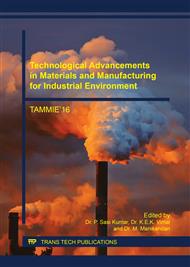p.81
p.88
p.97
p.105
p.112
p.119
p.127
p.134
p.148
Optimization Analysis of Process Parameters of Friction Stir Welded Dissimilar Joints of Aluminium Alloys
Abstract:
Friction stir welding (FSW) is one of the new technique for welding materials in solid state welding process. In this proposed work we are using FSW to join the two dissimilar alloys of aluminium. The 6mm thick aluminum plates of aluminium 5086 and aluminum 7075 plates are considered for welding. These have been considered due to their application in various fields. In this experimental process Taguchi’s L9 orthogonal array method is used for optimizing the three process parameters namely rotational speed, axial force and welding speed. To produce a better joint the tensile strength is predicted for the optimum welding parameters and also their percentage of contribution is calculated, by applying the effect of analysis of variance. Depends upon the experimental study, the rotational speed is found better over the other process parameters, which enhances the quality of the weld. The tensile strength has been found for the optimum parameters and the result found during the experiment was 290Mpa which was higher than the base metal strength of aluminium 5086 alloy. The SEM fractograph analysis was done on the optimum parameters welded joints to show the fracture behaviour of tensile test which justifies the visual inspection results of brittle and ductile failures.
Info:
Periodical:
Pages:
112-118
Citation:
Online since:
July 2017
Price:
Сopyright:
© 2017 Trans Tech Publications Ltd. All Rights Reserved
Share:
Citation:


